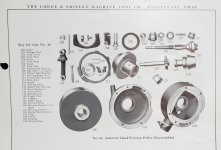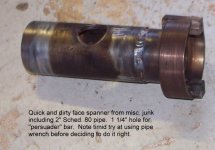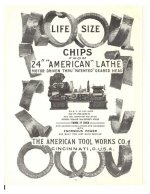So, I'm sort of the default machinist at work since I'm the only one with any desire to do it. I started three years back with a lathe I found on the side of the road for $900. I really like the old girl, but the manual for Lodge and Shipley in that era isn't exactly what you'd call informative. I also seem to have some features I haven't seen on any other machine.
It's a selective head 16"x12' from 1917. I have a taper attachment, an original and a shop made steady, and several different styles of tool holder. I've learned to thread on it, though I haven't quite got tapered threads figured out yet. The previous owner was making some type of air operated thing that I haven't figured out the purpose of, and there's some kind of system for attaching bars to the lathe for some purpose the manual doesn't explain well.
I'd like to get some new gears for it, because the ones installed seem to be a bit sloppy. Also, the taper attachment seems to sort of lag, and doesn't seem to make the taper you set on the dial. At 3" per foot, it seems like a 3" shaft should taper to a point at 6", but it doesn't.
I've been told there are some real Lodge and Shipley aficionados here, and I'm hoping someone knows some things.
Tailstock with mystery hole bored in one stud: https://i.postimg.cc/k440JkhS/20220504-133248.jpg
Gear train possibly missing a cover: https://i.postimg.cc/fb2wf7Gx/20220504-133036.jpg
Threading legend. I understand how to set a number of threads to cut, but neither I nor a guy that has been in machine shops since the '40s know what the heck a 'FDS' is. https://i.postimg.cc/qMVpwv5Z/20220504-133044.jpg
Weird, badly explained bar mechanism and previous owner's mystery air operated something: https://i.postimg.cc/k4KpgqvB/20220504-133056.jpg
Opposite end of bar mechanism with slot: https://i.postimg.cc/PqmWLx0s/20220504-133108.jpg
Anyway, the machine has some foibles I'd like to work out of it, but has been a good machine. I'm sure there's an adjustment procedure for the clutch, and as much as I am told they're supposed to leak a little, I'm sure oil literally running out the back of the gearbox when you're half way on the sight glass isn't right. Leftmost gear lever doesn't engage in leftmost position unless you pull it left past the leftmost detent hole. Good luck keeping the tailstock any kind of centered. Need to know how to get the apron off/apart (and hopefully back together) to fix loose stuff inside. Someone's previous braze job is holding a plate loose behind the apron.
Despite these defects, I always seem to be able to make a part that works with it. Last spring we also set up a mill to add to our capabilities, a K&T 2D which I am also learning on. Haven't been able to convince the boss I need a shaper yet, but I am sure as soon as he wants internal splines I'll have to explain it to him again.
Anyway, looking forward to meeting some of the people here who know these machines, and maybe more than the (terse) manual has to say.
It's a selective head 16"x12' from 1917. I have a taper attachment, an original and a shop made steady, and several different styles of tool holder. I've learned to thread on it, though I haven't quite got tapered threads figured out yet. The previous owner was making some type of air operated thing that I haven't figured out the purpose of, and there's some kind of system for attaching bars to the lathe for some purpose the manual doesn't explain well.
I'd like to get some new gears for it, because the ones installed seem to be a bit sloppy. Also, the taper attachment seems to sort of lag, and doesn't seem to make the taper you set on the dial. At 3" per foot, it seems like a 3" shaft should taper to a point at 6", but it doesn't.
I've been told there are some real Lodge and Shipley aficionados here, and I'm hoping someone knows some things.
Tailstock with mystery hole bored in one stud: https://i.postimg.cc/k440JkhS/20220504-133248.jpg
Gear train possibly missing a cover: https://i.postimg.cc/fb2wf7Gx/20220504-133036.jpg
Threading legend. I understand how to set a number of threads to cut, but neither I nor a guy that has been in machine shops since the '40s know what the heck a 'FDS' is. https://i.postimg.cc/qMVpwv5Z/20220504-133044.jpg
Weird, badly explained bar mechanism and previous owner's mystery air operated something: https://i.postimg.cc/k4KpgqvB/20220504-133056.jpg
Opposite end of bar mechanism with slot: https://i.postimg.cc/PqmWLx0s/20220504-133108.jpg
Anyway, the machine has some foibles I'd like to work out of it, but has been a good machine. I'm sure there's an adjustment procedure for the clutch, and as much as I am told they're supposed to leak a little, I'm sure oil literally running out the back of the gearbox when you're half way on the sight glass isn't right. Leftmost gear lever doesn't engage in leftmost position unless you pull it left past the leftmost detent hole. Good luck keeping the tailstock any kind of centered. Need to know how to get the apron off/apart (and hopefully back together) to fix loose stuff inside. Someone's previous braze job is holding a plate loose behind the apron.
Despite these defects, I always seem to be able to make a part that works with it. Last spring we also set up a mill to add to our capabilities, a K&T 2D which I am also learning on. Haven't been able to convince the boss I need a shaper yet, but I am sure as soon as he wants internal splines I'll have to explain it to him again.
Anyway, looking forward to meeting some of the people here who know these machines, and maybe more than the (terse) manual has to say.









